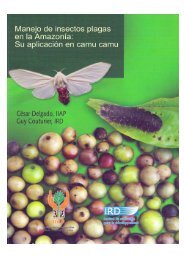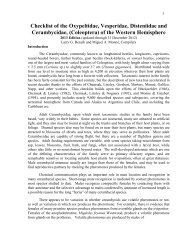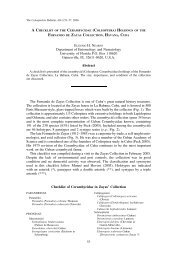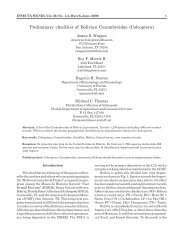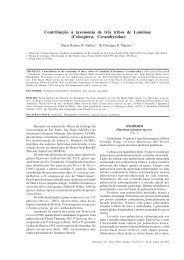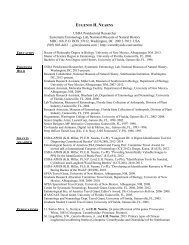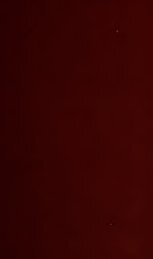You also want an ePaper? Increase the reach of your titles
YUMPU automatically turns print PDFs into web optimized ePapers that Google loves.
146 ''£HE T.RIBE ONCIDERlNI<br />
somewhnt transverse, about one-third wider than long, sides irregular, feebly ob<br />
lique, ncar apex more strongly narrowed, behind middle fl. small, distinct tubercle,<br />
before and behind which is n strong depression; npieai transverse sulcus lllUTOW,<br />
feebly impressed, obsolete at middle, basal one fine, shallow, merging with the<br />
lateral oblique ones ; disk with median tubercle anteriorly feebly c!ev·ated, more<br />
strongly so bns.'l.lIy, each side of this behind anterior sulcus 8. much more pro<br />
nounced, 8ubglob08e tubercle, laterally a flattened tubercle which is indistinctly<br />
prolonged to middle of base by a narrow elevation. Scutellum slightly transverse,<br />
sides straight, oblique, ftpex broad, feebly rounded. Elytra ",-jth sides slightly tapering<br />
posteriorly, apices cn'ch angularly rounded; disk with baSllI gibbosity broad,<br />
slightly oblique, not very prominent, extreme base smooth, t.hence finely granulate<br />
p\mctate, laterally and behind gibbosity punctures coarser but simple, behind<br />
humeri coarsely, rugosely punctate, on apical half punctures finer and rather obso<br />
lete; humeri prominent, anterior margin broadly arcuate, slightly oblique, angle<br />
with a distinct tubercle. Prosternum simple, narrow, n. little wider toward base ;<br />
mesosternal process e."{pandcd posteriorly, apu emarginate. Procoxae anteriorly<br />
with a long, slender tubercle, curved but not 3.1way uncate; femora robust, clavate,<br />
metafemora shorter and more slender, profemora at base finely, transversely rugose;<br />
meso- {lnd meta tibiae rnther strongly expanded apica!ly. Fifth sternite longer than<br />
fourth, apex broadly truncate. Antennae one and one-fourth times body length,<br />
eighth segment attaining e1ytral apex, sparsely fimbriate on four most proximal<br />
segmentsj scape nearly attaining middle of pronotum, rather slender, slightly arc<br />
uate, clavate on apical two-.fifths, beneath at base with four to six coarse rugositiesj<br />
third segment one-quarter longer than first, distinctly sinuous; fourth equal to first,<br />
rest shorter, subequal to onc another; eleventh a little more elongate, acicular.<br />
FEMALE. More robust; head with front bra.'1der, feebly narrowed above, an·<br />
tennal tubercles unarmed or feebly so; prosternum a little broader ; proooxae unarmed,<br />
profemora not rugose, tibiae not srongly expanded to apex; fifth sternite<br />
one-half longer than fourth, apex broadly rounded, on apical three-fourths a strong,<br />
subtriangular impressionj antennae very little longer than body, scape not rugose<br />
at base.<br />
LENGTH 14-18 mm; width 5.2-7.3 mm.<br />
Holotype.-Male ; Pirapora, Minas Geraes, Brazil, November<br />
11-13, 1919;- (H. G. Harris) ; [C.U. No. 2167).<br />
Allotype.-Female; same data as holotype ; [C.U.].<br />
Pat·atypes.-Male, female; same data as holotypej [C.U.]. Female<br />
; Chapada, Brazil ; [C.M.].<br />
PRISCATOIDES Dillon and Dillon, gen. nov.<br />
Differs from Esonius in having the pronotum strongly constricted<br />
at apex, unarmed latrally, basal sulcus sinuate ; elytra<br />
with basal gibbosities more strongly elevated, humeri much more<br />
projecting, their anterior margins much more oblique ; antennae<br />
more strongly clavate on apical half, third segment feebly bisinuate.



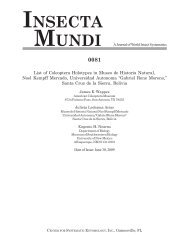
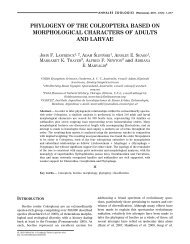


![Coleoptera. Vol. I. [Longicornia. Part I.]](https://img.yumpu.com/41202793/1/180x260/coleoptera-vol-i-longicornia-part-i.jpg?quality=85)
